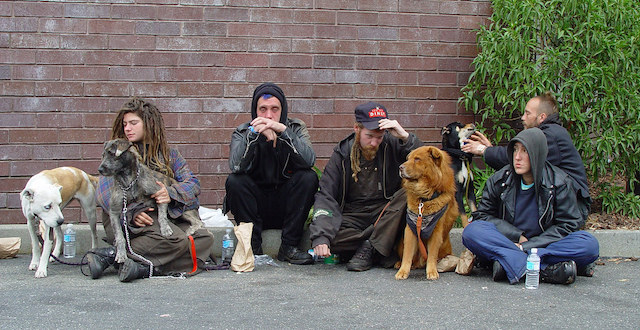The owner of San Francisco’s first and fourth largest hotels announced Monday that it is going to walk away from the mortgage it owes for those buildings. The owners of the Hilton Union Square Hotel noted that San Francisco’s path to recovery remains clouded and elongated by major challenges,” including the fact that fewer groups want to hold conventions in a city now more famous for its homeless population than its cable cars and restaurants.
Once famous as the center of the 1960s counterculture, Haight Street is now the home of a new kind of counterculture. Photo by Franco Folini.
Last month, Nordstrom said that it was closing both its stores in downtown San Francisco. “The dynamics of the downtown San Francisco market have changed dramatically over the past several years,” said a Nordstrom official, “impacting customer foot traffic to our stores and our ability to operate successfully.”
The month before that, Whole Foods closed its downtown San Francisco store. The company cited safety concerns for its employees, but drug-related retail theft also played a role in the decision.
Downtown San Francisco has recovered the least of any of the nation’s 52 largest downtowns, with only 32 percent of pre-pandemic economic activity in February of this year. Some wonder whether the city has entered a doom loop as each new announcement of a closure reduces the viability of those businesses that remain.
Some people hope that downtown’s decline will make housing more affordable, but this seems unlikely as the two markets are pretty separate. Most people who work downtown probably don’t live in the city of San Francisco and most people who live in the city don’t work downtown. In other words, people choose to live in San Francisco for reasons other than its proximity to downtown, so what happens downtown isn’t necessarily going to have an impact on the rest of the city. In fact, it might push up rents as businesses leaving downtown might relocate in other parts of the city.
For housing to become more affordable, the city would have to become hollowed out similar to St. Louis, which lost almost two-thirds of its population between 1950 and 2020. That’s not likely to happen to San Francisco, which remains a romantic place to live even if its downtown is no longer a romantic place to work. Nor will housing supply problems be eased by converting office buildings into apartments: the cost of doing so would be so great that it wouldn’t be affordable even by San Francisco standards.
Instead, what is most likely to happen is that high-rent paying downtown businesses such as major banks and large corporations will be replaced by lower-rent paying tenants such as small businesses, educational institutions, and non-profits. The rents they pay won’t be enough to cover the mortgages on giant skyscrapers, so more property owners will go bankrupt or walk away to be replaced by other owners unencumbered by the debts required to construct the buildings. Vacancy rates will remain high, though not as high as they are today, and many people will work in offices only one or two days a week, so transit ridership won’t recover to pre-pandemic levels.
None of this is going to happen without a lot of hysteria aimed at giving taxpayer subsidies to downtown property owners, transit agencies, and other parties. However, unless San Francisco gets its drug and homeless problem under control, nothing is going to stop the decline of downtown.









It will be interesting to watch cities run out of tax receipts while begging state and federal governments to pay for their upkeep. These cities have far to fall, and it will take decades before they hit bottom.
Without massive federal subsidies (which, unfortunately, will happen) San Francisco would, like the Hemingway quote–go bankrupt slowly and then suddenly.
Suddenly is almost here.
I say this with heavy heart , San Francisco will not be saved. Progressive policies that neuter cops and reward bad guys are but response to VOTER BASE. Years ago I wrote how low iQ groups cannot sustain a democracy or beneficial form of personal governance.
Beyond that effects of mass migration pander as voter base. Average Hispanic iQs are in the mid 80s. It has been tracked for 4-5 generations, (and proven via high-school dropout rates) and is effectively permanent.
Only less than 3% of Whites and 2% Asians score that low. You can’t hand reigns of civilization over that 3% and expect long-term positive outcomes. Violence, fanaticism, poor decision making, inept financial literacy follow these brackets. Geopolitical stability and personal freedoms cannot survive average iQ below 90. Lock up and leave.
Had we been allowed to discuss IQ and cognitive research colleges largely banned after WWII; at best discuss at Army war college among military planners the Iraq/Afghanistan Wars would never have occurred…Because no one would have been under the illusion something resembling a “Jeffersonian Republic” would emerge from nations with iq in the 70s low 80s.
Indigenous iQs are in low mid 80s range. Hispanics/Latinos occupy that bracket. Since post 60s communist favor uprisings in Latin America White Spaniards were removed from office and replaced with Hispanic leadership. IQ in Sub-Saharan Africa is high 60s to mid 70s.. they were brought over by millions as slaves, majority died rest interbred, along with MesoAmerican peoples became contemporary Latinx.
The results dragged average iQs in Latin America down 19-15 points. It was not gonna yield positive outcomes. No racism and bigotry, just biology and truth.
The title of this post reminded me of a documentary I saw a few years ago, called “Seattle is Dying”.
It’s a real eye opener and well worth an hour of your time. (On YouTube, over 105,000 comments have been written on it.)
https://youtu.be/bpAi70WWBlw
@antiplanner,
I’m surprised you didn’t mention the Turkey earthquake that killed 60k people. 90% of the buildings that collapsed were tall mixed-used buildings with “soft stories” that housed commercial uses below residential.